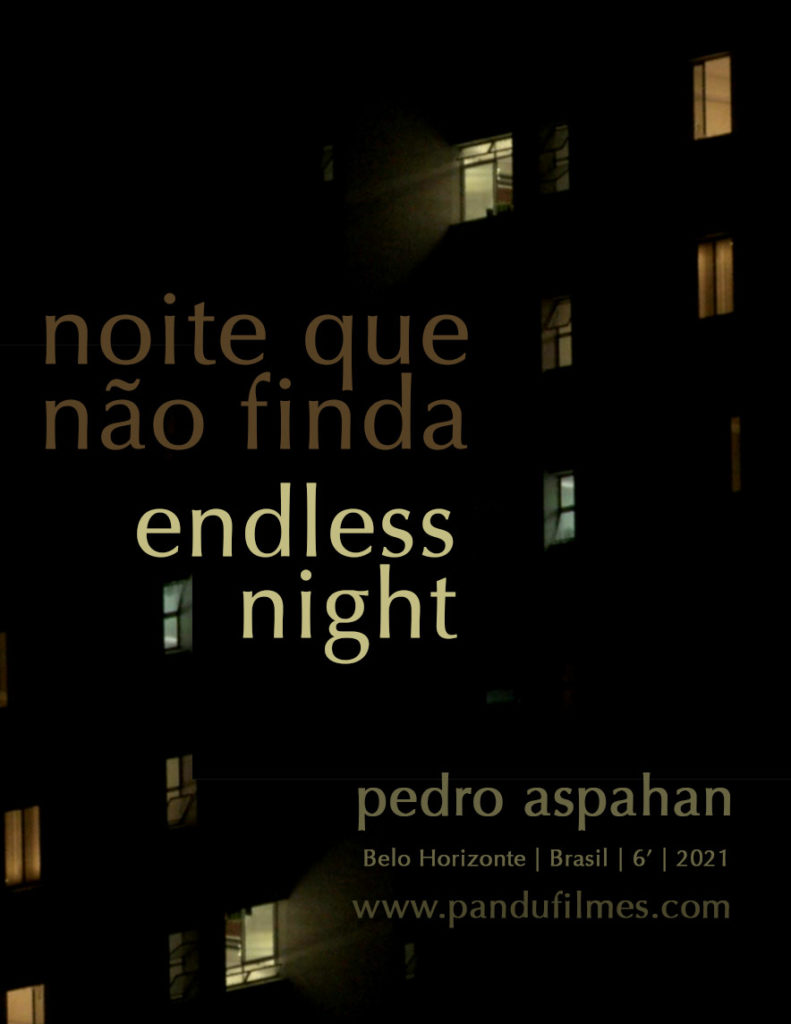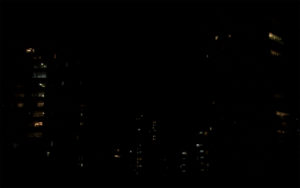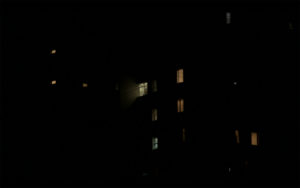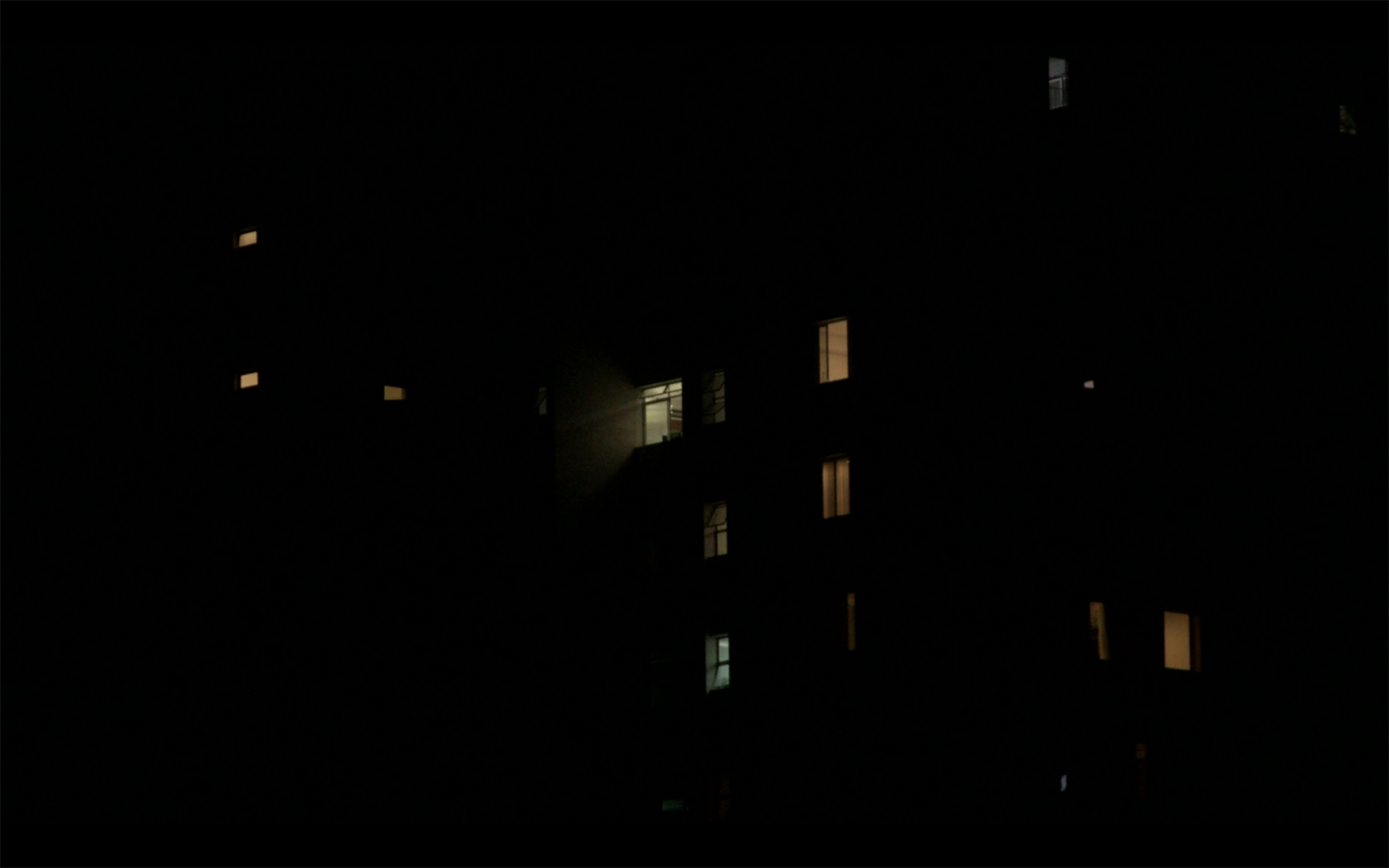Realização | Composição Musical Original | Sopros/Clarineta
Pedro Aspahan | 2020 | 6′

Sinopse
Os acordes marcam cada luz que se apaga na cidade. Noite que não finda. A forma do filme e a composição musical foram construídas a partir de princípios matemáticos de progressão exponencial correlatos ao processo de disseminação descontrolada do Corona Vírus no Brasil, como forma de prestar homenagem e de elaborar a perda de mais de 60 mil vítimas da doença no país (dados de julho de 2020).
Synopsis
The chords mark every light that is turned off in the city. Endless night. The form of the film and the musical composition were built based on mathematical principles of exponential progression related to the process of uncontrolled dissemination of the Corona Virus in Brazil, as a way to pay tribute to the more than 60,000 victims (in july of 2020) of the disease in the country.




Sobre o projeto
O apagar de uma luz em uma janela da cidade noturna pode ser visto de forma poética, como velas que deixam de brilhar, abandonando o calor e a vida de seu ambiente, sugerindo também as vidas que se apagam diante da pandemia no país, enquanto outras luzes se mantêm acessas, velando a noite que não finda. O filme é uma forma de prestar homenagem e de elaborar a perda dessas inúmeras vítimas, incluindo uma pessoa querida de minha família que foi precocemente vitimada pela doença.
Partimos das imagens noturnas da cidade, destacando os momentos em que as luzes de janelas se apagam, muitas vezes de modo bastante imperceptível para o nosso olhar. A experiência do filme oferece ao espectador uma sensação de perda, como se ele não conseguisse reter ou capturar o que acaba de acontecer à sua frente. A música caminha no sentido contrário, destacando, com acordes, cada luz que se apaga.
No processo de construção da forma fílmica utilizamos o princípio matemático de progressão exponencial, próprio à propagação descontrolada da doença, para marcar cada passagem à tela preta. O primeiro intervalo em preto tem apenas 6 frames de duração, o segundo tem 12 frames, o terceiro, 24 frames (um segundo), até chegarmos ao ápice, no último intervalo, com 1 minuto de tela em preto: um minuto de silêncio das imagens em homenagem às vítimas, enquanto os etéreos sons musicais agonizam nos agudos. O filme tem 6 minutos exatos de duração e foi feito quando atingimos 60 mil vítimas. Cada minuto do filme homenageia 10 mil vítimas. O filme produz um alargamento e uma angustiante densificação da noite que se aprofunda.
A construção da música também é feita usando o princípio da progressão matemática na aplicação de um crescente acúmulo de notas agudas da série harmônica, seguindo a sua lógica numérica intervalar: nota fundamental, oitava, quinta, e assim sucessivamente, o que corresponde às divisões da nota fundamental por valores progressivos: dividido por 2, 3, 4, 5, 6, 7 etc… até o último harmônico possível na tessitura da clarineta, caminhando sempre na direção dos agudos.
Decidi trabalhar com o instrumento de sopro, a clarineta, não só por ser o instrumento com o qual venho me dedicando intensamente a aprender durante a quarentena, mas principalmente, por seu som ser produzido a partir de um sopro, algo que dialoga com os movimentos da respiração, da vida e da morte, e com os dilemas da Covid-19, que é uma doença respiratória: inspiração e expiração. Além disso, o sopro coloca em questão a própria origem mítica da humanidade, o sopro de vida sobre a matéria, e coloca também a ameaça do último suspiro, que nos visita e que se torna onipresente diante da pandemia.
Para tocar o instrumento é preciso soprar, ficar sem ar durante a produção das notas, parar de respirar. Nesse sentido, a melodia principal vai se estabelecendo através de sopros os mais longos possíveis, até o completo término do ar na caixa torácica, produzindo um cansaço físico extenuante no instrumentista e um conjunto interessante de variações microtonais na afinação.
A cada nova luz que se apaga, uma nova nota mais aguda da série harmônica vem se somar à nota fundamental que ressoa contínua. Trata-se de um processo contínuo e progressivo de adição, em diálogo com as experimentações da música espectral, num jogo intenso de variações timbrísticas, com um certo nível controlado de aleatoriedade. No início, a música soa de forma bastante harmoniosa, por se tratar dos primeiros harmônicos consonantes da série, mas ao longo do tempo, com as adições progressivas dos harmônicos, a complexidade dos intervalos sonoros vai se ampliando e atingindo um nível extremo de dissonância no desenvolvimento da série, com intervalos de segundas maiores e menores em conflito nas notas mais agudas.
Esse movimento de construção da tensão e da dissonância se rarefaz no final, num breve instante em que as notas ainda ressoam antes de lermos o título do filme, quando uma última nota aguda dissonante ressoa solitária sobre a fundamental e podemos perceber com mais clareza a dificuldade do sopro em manter a nota longa por tanto tempo, pois o ar vai se acabando e a afinação oscila.
Esse grande movimento musical progressivo também intensifica a nossa sensação de angústia provocada pela quarentena, pois, no país, a situação tem se agravado e se intensificado de modo progressivo, sem recuos e sem perspectivas de melhora, como uma noite que não finda.
About the project
The extinguishing of a light in a window of the night city can be seen in a poetic way, like candles that cease to shine, abandoning the heat and the life of their environment, also suggesting the lives that go out in the face of the pandemic in the country, while others lights stay on, watching over the night that never ends. The film is a way of paying homage and elaborating on the loss of these countless victims, including a loved one from my family who was early victimized by the disease.
We start from the night images of the city, highlighting the moments when the window lights go out, often in a way that is very imperceptible to our eyes. The experience of the film offers the viewer a sense of loss, as if he is unable to retain or capture what has just happened in front of him. The music goes in the opposite direction, highlighting, with chords, each light that goes out.
In the process of constructing the filmic form, we used the mathematical principle of exponential progression, proper to the uncontrolled spread of the disease, to mark each passage on the black screen. The first black interval is only 6 frames long, the second is 12 frames long, the third, 24 frames (one second), until we reach the summit, in the last interval, with 1 minute of black screen: one minute of silence from images in honor of the victims, while the ethereal musical sounds agonize in the treble. The film is exactly 6 minutes long and was made when we reached 60,000 victims. Every minute of the film honors 10,000 victims. The film produces an enlargement and an agonizing densification of the deepening night.
The construction of the music is also done using the principle of mathematical progression in the application of an increasing accumulation of high notes of the harmonic series, following its interval numerical logic: fundamental note, octave, fifth, and so on, which corresponds to the divisions of the fundamental note by progressive values: divided by 2, 3, 4, 5, 6, 7 etc … until the last possible harmonic in the clarinet’s tessitura, always moving towards the treble.
I decided to work with the wind instrument, the clarinet, not only because it is the instrument with which I have been dedicating myself intensely to learn during the quarantine, but mainly, because its sound is produced from a breath, something that dialogs with the movements breathing, life and death, and the dilemmas of Covid-19, which is a respiratory disease: inhalation and exhalation. In addition, the breath calls into question the very mythical origin of humanity, the breath of life over matter, and also poses the threat of the last breath, which visits us and which becomes omnipresent in the face of the pandemic.
To play the instrument it is necessary to blow, to be without air during the production of the notes, to stop breathing. In this sense, the main melody is established by blowing as long as possible, until the complete end of the air in the ribcage, producing an exhausting physical fatigue in the instrumentalist and an interesting set of microtonal variations in the tuning.
With each new light that goes out, a new higher note of the harmonic series is added to the fundamental note that resonates continuously. It is a continuous and progressive process of addition, in dialogue with the experiments of spectral music, in an intense game of timbristic variations, with a certain controlled level of randomness. In the beginning, the music sounds quite harmoniously, as it is the first consonant harmonics in the series, but over time, with the progressive addition of harmonics, the complexity of the sound intervals increases and reaches an extreme level of dissonance in the series development, with intervals of major and minor Mondays in conflict in the highest notes.
This movement of construction of tension and dissonance is rarefied at the end, in a brief instant in which the notes still resonate before we read the title of the film, when a last high dissonant note resonates solitary on the fundamental and we can perceive more clearly the difficulty the breath of keeping the note long for so long, because the air is running out and the pitch fluctuates.
This great progressive musical movement also intensifies our sense of anguish caused by the quarantine, because, in the country, the situation has worsened and intensified progressively, without retreat and without prospects for improvement, like a night that does not end.

